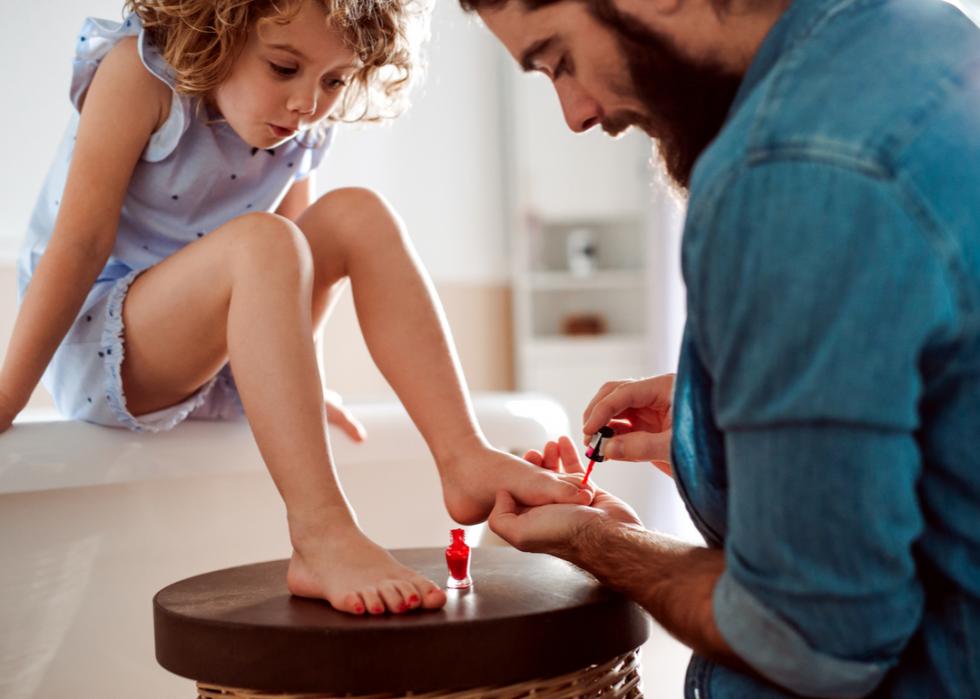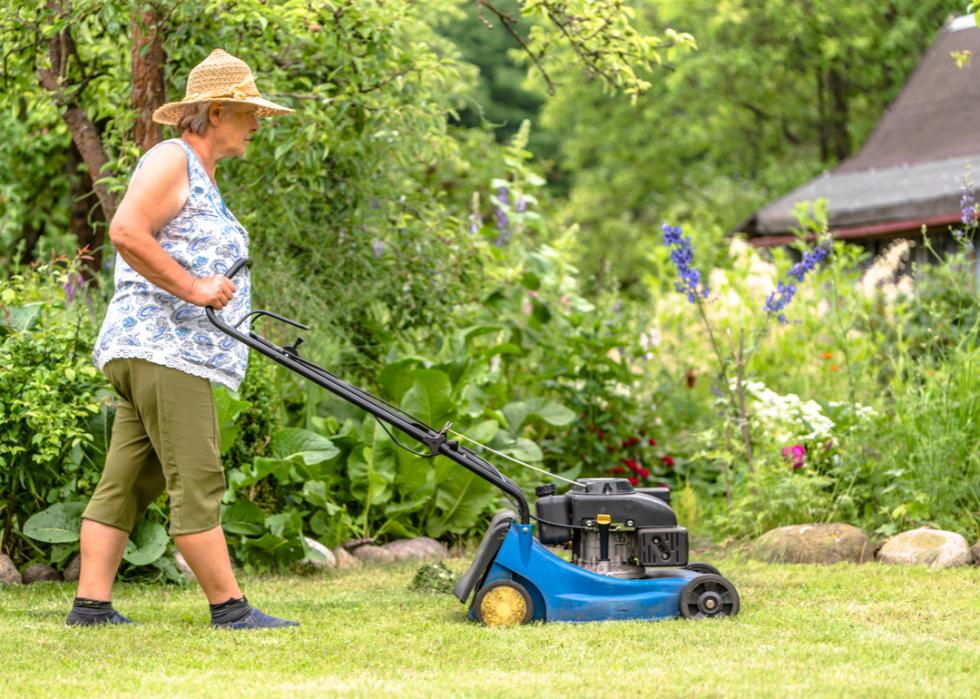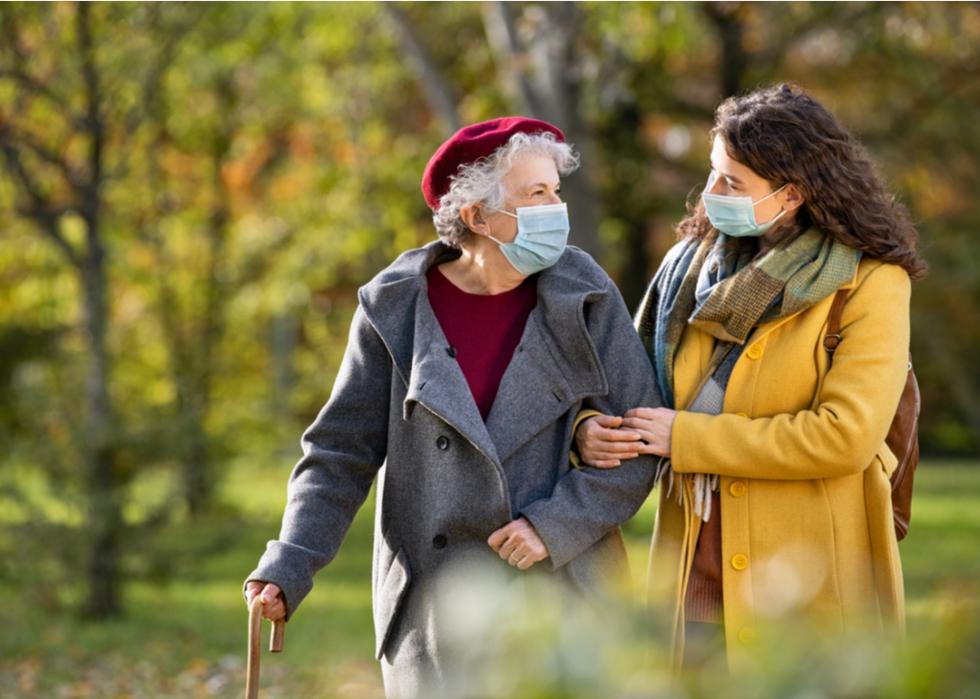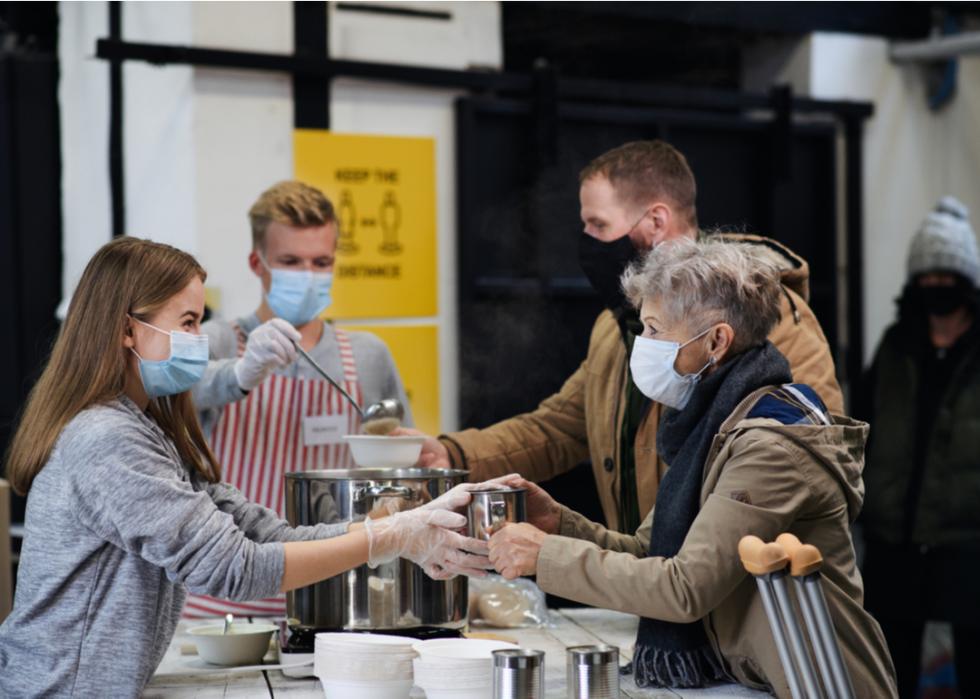
This story originally appeared on Persona Talent and was produced and distributed in partnership with Stacker Studio.
Here’s how people spent their time in 2020 v. 2019
When the COVID-19 pandemic took the world by surprise in 2020, massive job layoffs and furloughs followed, many U.S. states issued mandatory shutdowns of nonessential businesses, schools closed, social distancing orders were set in motion, and businesses were quickly forced to shift and adapt to a remote work environment.
For those who were able to keep their jobs and work remotely at the onset of the pandemic, lengthy commutes to an office or workspace were no longer necessary, which freed up time for some. However, parents who worked from home grappled with mounting Zoom calls and helping their children learn virtually while managing their household—resulting in working longer hours and at times causing burnout.
The pandemic brought the world to a halt and spurred significant lifestyle changes from work-life balance to spending habits. Persona Talent analyzed data from the American Time Use Survey collected by the Bureau of Labor Statistics to look at how people spent their time during 2020 compared to 2019. Data points for the average amount of time spent on an activity is based on responses from people who engaged in the activity rather than all respondents.
People with higher levels of education and those with high-earning jobs were more likely to work from home. People who worked in the hospitality and transportation industries and those who were deemed essential workers were least likely to work from home. The pandemic, especially in its earlier stages, drastically affected every aspect of life including work, socialization, communication, time spent on leisure, and management of household chores.
Some people took to DIY home improvement, creating and expanding home office spaces, some pet owners became just as invested in their furry friend’s grooming and maintenance as their own, and Americans couldn’t get enough of binge-watching on their favorite streaming services. Continue reading to discover how Americans spent their time in 2020 compared to the year before the pandemic.

Telephone calls, mail, and email
- Average daily time spent on activity, 2020: 1.04 hours (+37% change from 2019)
--- Among men: 1 hour (+37.0% change from 2019)
--- Among women: 1.06 hours (+35.9% change from 2019)
- Percent of population engaged in activity, 2020: 21.1% (+4.5% change from 2019)
--- Percent of men: 16.2% (-3.2% change from 2019)
--- Percent of women: 25.8% (+5.7% change from 2019)
The traditional phone call made a comeback in 2020 after previously being in decline. Despite social media being a popular method of communication in recent years, in times of crisis, people may prefer to be physically heard. For those with older relatives who may be at a disadvantage tech-wise, the familiar phone call filled the social void. People have also emailed more to keep in touch with loved ones who live far away. Reliance on technology was evident last year with an uptick in virtual gatherings such as birthday celebrations and weddings.

Sleeping
- Average daily time spent on activity, 2020: 9.02 hours (+2% change from 2019)
--- Among men: 8.92 hours (+1.6% change from 2019)
--- Among women: 9.11 hours (+2.4% change from 2019)
- Percent of population engaged in activity, 2020: 99.9% (0% change from 2019)
--- Percent of men: 99.8% (+.2% change from 2019)
--- Percent of women: 100% (+.1% change from 2019)
As Americans dealt with heightened levels of anxiety, with 98% developing sleep problems after stay-at-home orders, insomnia grew in popularity, according to a study by SleepStandards. “Sleep Habits Post Quarantine in the U.S. 2020” evaluated sleep habits before and after government-issued lockdowns caused by the pandemic.
The survey found that Gen Z and millennials went to bed later than other generations after quarantine with insomnia being prevalent in these age groups.
Gen X and baby boomers exhibited a more stable sleep routine throughout the quarantine but were also less likely to engage in activities such as exercise to improve sleep.

Grooming
- Average daily time spent on activity, 2020: 0.82 hours (-4% change from 2019)
--- Among men: 0.74 hours (+2.8% change from 2019)
--- Among women: 0.89 hours (-7.3% change from 2019)
- Percent of population engaged in activity, 2020: 73.7% (-7.9% change from 2019)
--- Percent of men: 69.5% (+9.2% change from 2019)
--- Percent of women: 77.7% (-6.7% change from 2019)
As hair salons and barbershops closed along with other businesses, Americans reprioritized their self-care and grooming needs, taking a DIY approach. Despite the global health crisis, Americans were determined to maintain their appearance with an estimated $3.7 billion surge in health and cosmetic sales in the summer of 2020 compared to the same time in 2019, according to Nielsen. Some of the most popular items purchased during the lockdown included clippers, nail polish, press-on nails, and hair dyes.
Nielsen’s data showed that men also wanted to remain presentable, with sales of men’s hair clippers in physical stores skyrocketing 53% to $59 million. Although some retailers were temporarily closed, consumers were still able to purchase beauty and other grooming items from stores such as Target and Walmart.

Eating and drinking
- Average daily time spent on activity, 2020: 1.11 hours (0% change from 2019)
--- Among men: 1.13 hours (+2.7% change from 2019)
--- Among women: 1.09 hours (-1.8% change from 2019)
- Percent of population engaged in activity, 2020: 96% (+.3% change from 2019)
--- Percent of men: 96.1% (-.1% change from 2019)
--- Percent of women: 96% (+.7% change from 2019)
At the onset of the pandemic, with restaurant closures lasting for several months and some shutting down permanently, people explored new recipes and generally got crafty in the kitchen. Americans spent less money on food away from home in 2020 than in 2019, according to the U.S. Department of Agriculture.
Americans however did spend 1.4% more on food from supermarkets, convenience stores, and other retailers. The global health crisis also triggered healthier eating and wellness habits with Americans purchasing more locally grown produce, plant-based foods, and immunity-boosting supplements. Along with the healthier approach, simultaneously there was a boost in alcohol intake with heightened liquor store sales. A Columbia Health report showed increased alcohol sales from March to September of 2020 by 20% compared to 2019.

Housework
- Average daily time spent on activity, 2020: 1.73 hours (+13% change from 2019)
--- Among men: 1.47 hours (+23.5% change from 2019)
--- Among women: 1.83 hours (+8.3% change from 2019)
- Percent of population engaged in activity, 2020: 34.4% (-.9% change from 2019)
--- Percent of men: 20.5% (+8.5% change from 2019)
--- Percent of women: 47.6% (+2.8% change from 2019)
Both men and women spent extra time in 2020 cleaning and decluttering. The increased time at home—and perhaps the fact that coworkers could peer into living spaces during Zoom calls—inspired many to get their homes in order.
Cinch Home Services surveyed 1,030 people to gain insight into Americans’ cleaning habits to determine if there were differences from pre-pandemic times. A key takeaway: 72.9% of respondents admitted to cleaning up right before a Zoom call. The report also found that 64% of Americans intentionally refrained from purchases to keep their spaces decluttered, while 70% expressed they cleaned continuously from the start of the pandemic.

Food preparation and cleanup
- Average daily time spent on activity, 2020: 1.11 hours (+6% change from 2019)
--- Among men: 0.89 hours (+3.5% change from 2019)
--- Among women: 1.24 hours (+5.1% change from 2019)
- Percent of population engaged in activity, 2020: 59.8% (+1.4% change from 2019)
--- Percent of men: 47.1% (+1.9% change from 2019)
--- Percent of women: 71.7% (+3.3% change from 2019)
In 2020, Americans ate at home more than ever, cooking an average of nine meals per week. A survey conducted by consumer packaged goods sales and marketing firm Acosta, “COVID-19: Reinventing How America Eats,” released in September 2020, showed that since the pandemic, 55% of Americans prefer their meals at home with 44% opting to eat breakfast at home daily, compared to 33% pre-pandemic. Three out of five people considered ordering pre-made meals for convenience sake and two out of five people ordered meal kits before.
Many Americans enjoyed putting their culinary skills to the test, experimenting in the kitchen, but admitted to cooking fatigue. In a survey of 2,000 people conducted by OnePoll and Sun Basket, 55% of respondents said they felt fatigued from cooking at home so much due to the COVID-19 pandemic.

Lawn and garden care
- Average daily time spent on activity, 2020: 2.04 hours (+4% change from 2019)
--- Among men: 2.31 hours (0% change from 2019)
--- Among women: 1.65 hours (+7.1% change from 2019)
- Percent of population engaged in activity, 2020: 13% (+26.2% change from 2019)
--- Percent of men: 16% (-34.5% change from 2019)
--- Percent of women: 10.2% (+15.9% change from 2019)
Economic insecurity contributed to some homeowners canceling expert lawn and landscaping services and taking on the tasks themselves. Consumers were also wary about inviting maintenance and other professional workers into their homes, especially at the beginning of the pandemic. As a result, 2020 saw spikes in sales of gardening and other outdoor equipment such as plants, lawnmowers, and outdoor design and landscaping materials.

Household management
- Average daily time spent on activity, 2020: 0.87 hours (+14% change from 2019)
--- Among men: 0.89 hours (+27.1% change from 2019)
--- Among women: 0.85 hours (+6.2% change from 2019)
- Percent of population engaged in activity, 2020: 15.2% (-19.6% change from 2019)
--- Percent of men: 12.4% (+15.6% change from 2019)
--- Percent of women: 17.9% (-21.8% change from 2019)
Home renovation became particularly popular during the pandemic, with many shifting their vacation and travel budgets to DIY home projects. With many transitioning to work-from-home life or for those who became unemployed, one thing was for sure—more time would be spent at home. This led many to spruce up their home living spaces. Some people added home gyms while others installed decks or created additional space for a home office. A national survey conducted by The Freedonia Group in December 2020 showed that 39% of consumers reported taking on home improvement activities due to the pandemic.

Purchasing goods and services
- Average daily time spent on activity, 2020: 1.02 hours (-5% change from 2019)
--- Among men: 0.86 hours (-7.5% change from 2019)
--- Among women: 1.15 hours (-1.7% change from 2019)
- Percent of population engaged in activity, 2020: 37.2% (-13.9% change from 2019)
--- Percent of men: 33.3% (+11.9% change from 2019)
--- Percent of women: 40.9% (-15.1% change from 2019)
Consumer spending plummeted in spring of 2020 at the onset of the pandemic. Job losses, changes in income, shutdowns, and restrictions on social activities led consumers to spend less. Although spending quickly bounced back months later, it remained well below 2019 purchase levels. People spent less time shopping with 34% aged 15 and older shopping in 2020, compared to 40% in 2019.
Consumer spending picked up significantly after stimulus payments were distributed. According to Opportunity Insights’ Economic Tracker, credit and debit card data show low-income households held back on spending less than high-income households. However, low-income households reached pre-pandemic spending levels by September 2020.

Caring for and helping household members
- Average daily time spent on activity, 2020: 2.17 hours (+25% change from 2019)
--- Among men: 1.73 hours (+25.4% change from 2019)
--- Among women: 2.41 hours (+21.1% change from 2019)
- Percent of population engaged in activity, 2020: 19.6% (-18.0% change from 2019)
--- Percent of men: 14.1% (+32.2% change from 2019)
--- Percent of women: 24.8% (-7.5% change from 2019)
The pandemic caused a dramatic shift in just about everything, especially routine care for children as well as family members with disabilities or illnesses. Many schools, childcare providers, and workplaces were forced to close with stay-at-home orders in place, requiring parents to spend more time teaching and caring for their kids.
In 2019, adults who lived in a home with at least one child younger than 13 spent six hours providing additional childcare. For households with children between ages 6 and 12, even more time was spent juggling work and caring for the kids. Women consistently spent more time on homeschooling and overall childcare: 1.7 hours daily, compared to men, who spent 46 minutes daily caring for children in the household. Some caregivers weren’t taking care of small kids, but took care of assisting aging parents who may live with them instead. To ensure safety, some opted not to have the presence of home health aides in fear of being exposed to COVID-19.

Caring for and helping non-household members
- Average daily time spent on activity, 2020: 1.89 hours (+50% change from 2019)
--- Among men: 2.08 hours (+67.7% change from 2019)
--- Among women: 1.77 hours (+39.4% change from 2019)
- Percent of population engaged in activity, 2020: 7.5% (-29.9% change from 2019)
--- Percent of men: 5.9% (+31.4% change from 2019)
--- Percent of women: 9.1% (-28.3% change from 2019)
Being the primary caregiver for a loved one is stressful and overwhelming at any given time, but especially during the pandemic, which posed its own set of challenges. More precautions had to be taken to ensure the safety and prevention of COVID-19 spreading.
In 2020, Americans were advised to practice social distancing and to limit interactions with people outside of their households. This caution, however, didn’t stop 8% of the population aged 15 and older in 2020, who provided care or helped individuals who did not live with them, compared to 11% in 2019. Those who assisted non-household members spent 38 more minutes per day in 2020 than they did in 2019 helping those outside of the house.

Working and work-related activities
- Average daily time spent on activity, 2020: 7.49 hours (0% change from 2019)
--- Among men: 7.9 hours (+.9% change from 2019)
--- Among women: 7.01 hours (-1.7% change from 2019)
- Percent of population engaged in activity, 2020: 40.4% (-8.4% change from 2019)
--- Percent of men: 45.4% (+11.0% change from 2019)
--- Percent of women: 35.6% (-5.3% change from 2019)
For those who were still employed at the beginning of the pandemic, working from home doubled for Americans, from 22% in 2019 to 42% in 2020. There wasn’t a massive difference in how much Americans spent working overall with an average of 7.6 hours per day in 2020, compared to 7.7 hours per day in 2019. In 2020, due to the massive pandemic layoffs, 39% of Americans were in the workforce, compared to 43% in 2019. Almost half of women who were employed worked from home (a 23% spike from 2019), whereas 36% of men worked from home.

Religious and spiritual activities
- Average daily time spent on activity, 2020: 1.37 hours (-4% change from 2019)
--- Among men: 1.37 hours (-4.9% change from 2019)
--- Among women: 1.36 hours (-4.2% change from 2019)
- Percent of population engaged in activity, 2020: 6.9% (-24.2% change from 2019)
--- Percent of men: 4.8% (+18.6% change from 2019)
--- Percent of women: 8.9% (-26.4% change from 2019)
As the coronavirus pandemic disrupted billions of lives globally, many Americans leaned on religion and spirituality to help navigate unpredictable times. A Pew Research Center report from August 2020 found one in three U.S. adults watched religious services online or on television, and 12% of U.S. adults attended a religious service in person within the month.
More than half of U.S. adults (54%) who watched religious services virtually in August 2020 said it was something they started doing since the pandemic began, while 46% said they watched virtual services prior to the pandemic. There have been numerous studies that show people tend to draw close to religion and spirituality when faced with challenges. An October 2020 Pew report revealed that 35% of American adults believe the pandemic was sent as a lesson or lessons from God with 86% believing there are lessons that humankind can learn from the pandemic.

Volunteering (organizational and civic activities)
- Average daily time spent on activity, 2020: 2.1 hours (-9% change from 2019)
--- Among men: 2.1 hours (-21.1% change from 2019)
--- Among women: 2.1 hours (+1.9% change from 2019)
- Percent of population engaged in activity, 2020: 4% (-27.3% change from 2019)
--- Percent of men: 3.4% (+24.4% change from 2019)
--- Percent of women: 4.5% (-30.8% change from 2019)
Despite being encouraged to practice social distancing, Americans participated in humanitarian efforts during the earlier stages of the pandemic. In June 2020, many participated in protests following the murder of George Floyd, an incident that ignited global attention to continued systemic racism and police brutality in the nation. The pandemic, nationwide, witnessed a surge in community service interests.
Data released in August 2020 from LinkedIn showed its U.S. members added over 110,000 volunteer projects to their profiles each month in 2020 up until that point, a rate 2.5 times higher than 2017’s monthly count. Some organizations where Americans chose to devote their time included the American Red Cross, Crisis Text Line, Toastmasters International, and Wheels on Meals America.

Watching television
- Average daily time spent on activity, 2020: 3.88 hours (+8% change from 2019)
--- Among men: 4.19 hours (+8.3% change from 2019)
--- Among women: 3.59 hours (+7.5% change from 2019)
- Percent of population engaged in activity, 2020: 78.8% (+3.4% change from 2019)
--- Percent of men: 78.7% (-1.4% change from 2019)
--- Percent of women: 78.9% (+5.5% change from 2019)
Streaming apps such as Netflix and Hulu were hugely popular at the beginning of the pandemic. Watching TV, including live programming, DVDs, and streaming, took up a large chunk of time for Americans in 2020, more than any leisure activity. Americans watched television an average of 3.1 hours per day in 2020, according to BLS, which makes it the leisure activity that took up the most time across all demographics that year. Those 15 and older spent 19 more minutes per day watching TV in 2020 than in 2019. Overall, men gained 37 minutes of leisure time during the pandemic and women gained 27 minutes of leisure time.

Participating in sports, exercise, and recreation
- Average daily time spent on activity, 2020: 1.57 hours (-3% change from 2019)
--- Among men: 1.8 hours (-7.2% change from 2019)
--- Among women: 1.34 hours (+6.3% change from 2019)
- Percent of population engaged in activity, 2020: 23.4% (+17.0% change from 2019)
--- Percent of men: 24.2% (-11.5% change from 2019)
--- Percent of women: 22.6% (+22.2% change from 2019)
Gym closings and limited access to activities outside the home didn’t prevent Americans from working out during the pandemic. The time Americans spent engaged in leisure activities such as exercise and sports increased by 32 minutes per day in 2020, compared to 2019. People exercised more days per week but with less intensity—most likely due to the lack of access to gym equipment. Instead, people shifted to simple movement techniques such as outdoor walking. In 2020, the amount of time spent thinking and relaxing increased to 7 minutes more a day compared to 2019. There was also an increase in using the computer for leisure and playing games, which went up 10 minutes a day in 2020.



